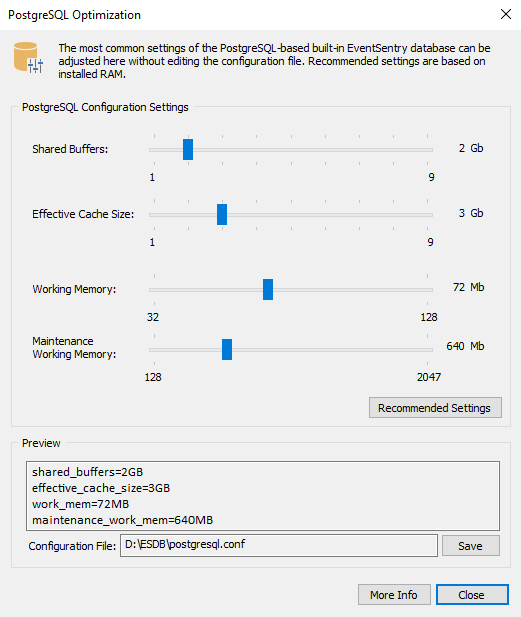Since the built-in PostgreSQL database is not tuned for performance by default, it's usually necessary to tweak some of the configuration settings to achieve better performance of the database. All settings for the built-in database can be changed by editing the PostgreSQL configuration files, but the most important performance-related settings can also be tweaked in the management console with the need to edit configuration files.
|
The EventSentry Database service has to always be restarted in order for new configuration settings to become effective. |
|
The PostgreSQL Optimization dialog can be accessed via:
•Ribbon: Tools -> Utilities -> Built-In Database Optimization •Database action dialog (PostgreSQL actions with local database only)
The dialog allows the tweaking of select configuration settings, all of which affect different aspects of the database performance. Hovering over the levers will show a tool tip with a description of each parameter.
Configuration File Found If the dialog is launched from a host where the EventSentry database is running locally, then the management console will attempt to parse the configuration file (postgresql_eventsentry.conf or postgresql.conf by default) and read the current settings for the listed configuration parameters. The applicable configuration will be shown in the "Configuration File" field if a file was successfully detected.
Clicking "Recommended Settings" will adjust the configuration settings based on the installed RAM. Clicking the "Save" button will write the active configuration file.
No Configuration File(s) Found If no configuration files are found, then the dialog will pre-select the recommended settings based on the currently available RAM and show a preview of the configuration parameters in the "Preview" section. These configuration parameters can then be pasted into any PostgreSQL configuration file.
More information on optimizing the performance of the built-in PostgreSQL database can be found in KB article 232. |

